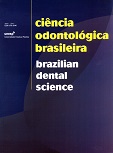Low level laser therapy for dentine hypersensitivity
DOI:
https://doi.org/10.14295/bds.2003.v6i4.542Resumo
Dentine hypersensitivity is a disease that affects both man and women, and it is an overreaction for a stimulusthat normally would not cause pain in a healthy tooth. The etiology is multifactorial, and the pain appears
specially when the cervical region dentine is exposed to the oral environment. The purpose of this work was to
test the efficiency of application of the gallium-aluminum-arsenide diode laser (GaAlAs) in the treatment of
dentine hypersensitivity. Fifty teeth were selected from patients of the São José dos Campos School of Dentistry
- UNESP who presented dentine hypersensitivity. The Local Ethics Committee approved this work. The patients
were questioned about pain, and after tactile (probe) and evaporative stimuli (air jet), scores were attributed
and recorded in an analogous visual scale: score 10 (unbearable pain); 7 to 9 (strong and bearable pain), 4 to
6 (moderate pain), 1 to 3 (light pain) and 0 (no pain). The laser was applied on the surface that presented
sensitivity (non contact) for 2 minutes at 15mW. The scores were attributed before and after each application.
No more than 3 applications were performed, with an interval of seven days between them. The results were
analyzed by the non-parametric Friedman analysis of variance (p<0.001) and by Tukey multiple comparison test
(p<0.05). The percentage of teeth that presented absence of pain to the evaporative test altered from 2% (beginning)
to 62% (end of treatment), and to the tactile test from 46% to 86%, significant statistically. It was concluded
that the treatment performed was effective for the reduction of dentine hypersensitivity.
Downloads
Downloads
Publicado
Como Citar
Edição
Seção
Licença
TRANSFERÊNCIA DE DIREITOS AUTORAIS E DECLARAÇÃO DE RESPONSABILIDADE
Toda a propriedade de direitos autorais do artigo "____________________________________________________________________" é transferido do autor(es) para a CIÊNCIA ODONTOLÓGICA BRASILEIRA, no caso do trabalho ser publicado. O artigo não foi publicado em outro lugar e não foi submetido simultaneamente para publicação em outra revista.
Vimos por meio deste, atestar que trabalho é original e não apresenta dados manipulados, fraude ou plágio. Fizemos contribuição científica significativa para o estudo e estamos cientes dos dados apresentados e de acordo com a versão final do artigo. Assumimos total responsabilidade pelos aspectos éticos do estudo.
Este texto deve ser impresso e assinado por todos os autores. A versão digitalizada deverá ser apresentada como arquivo suplementar durante o processo de submissão.




























